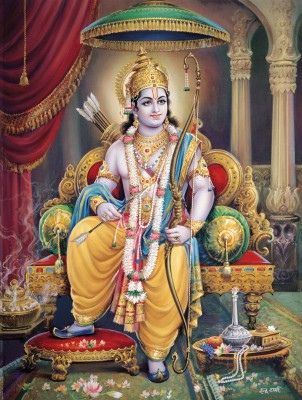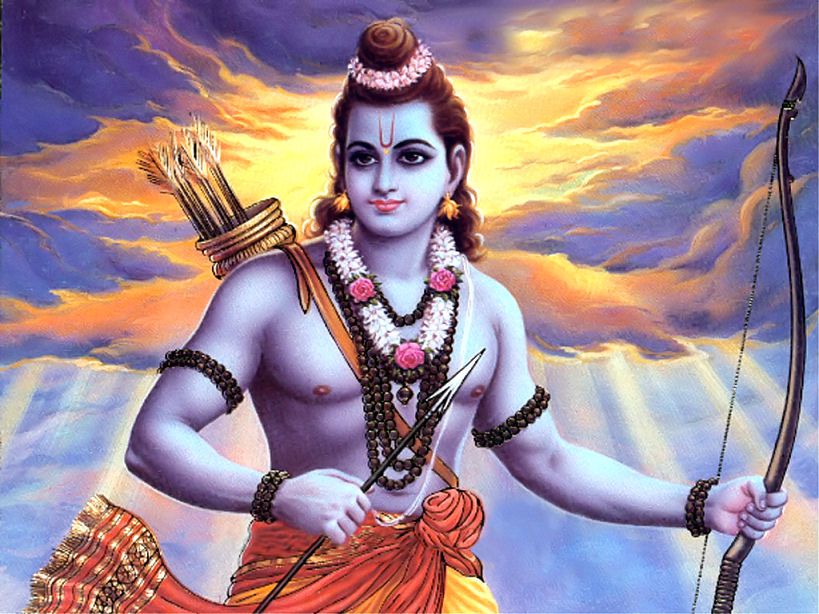No products in the cart.
Lord Rama is known as the seventh incarnation of Lord Vishnu. Rama, the perfect avatar of the Supreme Protector Vishnu, has always been popular among the Hindu deities. Rama is the symbol of courtesy and virtue, a man of values and morals. Ramachandra is Maryada Purushottam, which means the perfect man. Lord Rama is considered to have taken birth on earth to destroy the evil forces of the age. Lord Rama, in the words of Swami Vivekananda, is “the embodiment of truth, of morality, the ideal son, the ideal husband, and above all, the ideal king”. Rama is widely accepted to be an actual historical figure – a “tribal hero of ancient India” – whose deeds form the great Hindu epic of Ramayana or The Romance of Rama, written by the ancient Sanskrit poet Valmiki. According to the Hindus belief, Rama lived in the Treta Yug. Although historians are of the conviction that Rama was not particularly deified until the 11th century AD. Tulsidas’ wonderful version of the Sanskrit epic “Ramayana” into “Ramcharitmanas” greatly enhanced the popularity of Rama as a Hindu god and gave rise to various devotional groups.
Shri Ram – The Maryada Purushottam
Shri Rama was a paragon of virtues. Rama was not only kind and affectionate but generous and considerate of feelings for all around him. Lord Rama had a marvelous physique and captivating manners. Shri Ram had a magnanimous personality. He was extremely noble, generous, chivalrous and fearless. He was very simple and absolutely free from flamboyance. Lord Rama is considered as a son unequaled in the world, and resembled Dasaratha in each and every aspect of good qualities. He never spoke a lie throughout his life. He always offered respect to the scholars and the elders, people loved him and he adored the people. His body was transcendental and outstanding. He was eloquent, attractive and adjustable to circumstances. He knew the heart of each and every human being on the earth (being omniscient). He had all the conceivable qualities of a king’s son and was dear to the people as their own hearts. Lord Rama was endowed with incredible transcendental qualities. The earth personified adored him, who was possessor of such virtues, who was indomitable, who was brave, and who was the unequalled Lord of all. To put succinctly, Sri Rama’s life was a life of holy compliance, of stainless purity, of matchless simplicity, praiseworthy contentment, commendable self-sacrifice and remarkable renunciation.
Why is Shri Ram is called Maryada Purushottam?
Ramayana is invested with many episodes. Each contributed to the smooth run of the plot of the text. Returning back to Ayodhya after killing Ravana, Ram was coroneted as king of Ayodhya. They had an efficient system of obtaining feedback from the public on the basis of which laws were made for the welfare of the public. Some of these feedbacks were very disturbing. They were all about Sita and how she could not be accepted back as queen after staying with Ravana. Initially these feedbacks were ignored. Slowly these feedbacks started increasing and dissatisfaction became much more apparent.
 But Ram is not called Maryada Purushottam just as a mark of respect. He always respected the existing tradition (Maryada) of that time. Shri Rama respected the citizens. He respected the people’s talks. He declared that Sita had to pass the Agni Pariksha test so that he could accept her back. Laxman strongly opposed this. Yet the victorious army chief insisted that Agni Pariksha was the only thing which could make him accept her. Sita agreed and after the satisfactory completion of the ritual ‘Agni Pariksha’, Shri Ram gladly accepted her back as his wife.
But Ram is not called Maryada Purushottam just as a mark of respect. He always respected the existing tradition (Maryada) of that time. Shri Rama respected the citizens. He respected the people’s talks. He declared that Sita had to pass the Agni Pariksha test so that he could accept her back. Laxman strongly opposed this. Yet the victorious army chief insisted that Agni Pariksha was the only thing which could make him accept her. Sita agreed and after the satisfactory completion of the ritual ‘Agni Pariksha’, Shri Ram gladly accepted her back as his wife.
Ram did it not because he personally doubted Sita but because of the demands of his dharma as a king; he knew she was innocent but he had to show his praja (subject) that unlike his father, he was not a slave to a woman, that as a just Raja he was willing to make any amount of personal sacrifices for them. It was an act of sacrifice for him as well. He suffered no less, and lived an ascetic life thereafter.
Firstly, Sri Rama did not treat His wife badly. Sita didn’t think He did, so it is none of our business to pass judgments. Sri Rama and Sita are the perfect couple, completely harmonious to each other to such an extent that they used to understand the thought process of the other without saying! That is the reason, even now people invoke their blessings on wedding cards even if they ignore all other forms of God. You will never find a temple dedicated to Sri Rama without His consort Sita beside Him. That is not true for any other form of God, whether Vishnu, Siva, etc. Also, it is said that you should always say “Sri Rama”, rather than just Rama. Here “Sri” signifies Sita. Also, no one, not even their children, are supposed to walk in between any couple. They should always walk around them. This custom was started in respect of Sita-Rama. Even Hanuman, the greatest devotee of Sri Rama, after seeing Mother Sita crying in Ashokavana in Lanka, says that Ravana is already dead by the tears of Sita. It is only a formality that Sri Rama should come to Lanka and kill Ravana in war. He further states that both Sri Rama and Sita are a boon given by each to the other. Sage Valmiki sets about to write Ramayana (The journeys of Rama), but at the ends calls his story as “Sitaya charitam mahath” (The great story of Sita).
Shri Ram’s Adherence to Dharma
Mother Sita is proud of Her Husband’s adherence to dharma. In fact in Ramayana, She proudly says that Sri Rama didn’t accept her hand in marriage immediately after breaking Lord Siva’s bow.
At that time, Sri Rama said that dharma dictates that it is not Him, but it should be his father King Dasaratha who decides His bride. He had broken the bow at the orders of His Guru Sage Vishwamitra, whom He is following at the orders of His father. Another example to show Sri Rama’s love for His wife Sita. Sri Rama being sent to forests was due to cosmic play of Gods who wanted Ravana to be killed. But after coming to the forests for 14 years, Sri Rama happily spends His time in the company of His consort Sita and His brother Lakshman for 13 years. He won’t go to any war on Ravana. In the last year of vanavas, gods got tired of waiting and wanted to find out the reason for which Sri Rama will get very angry, so that they can use it to get Ravana killed! So King of Gods Indra sends his son Kakasura in the form of a crow. This crow first tries to irritate Sri Rama and Sita by kicking them with its legs. Sri Rama doesn’t care! Later when He sleeps in the lap of Sita, this crow attacks Sita and removes a chunk of flesh from Mother Sita’s bosom. Sita doesn’t move or cry out as it will disturb Sri Rama’s sleep. But a drop of blood falls on Sri Rama’s face and He wakes up. He sees what happened and gets into a rage. He immediately picks up a blade of grass nearby and invokes the Brahmastra into it and shoots it at the crow.
Imagine the deadly Brahmastra chasing a lowly crow! The gods understood that Sri Rama will get angry only if Sita suffers due to someone and then decides to use this to plan the whole war on Ravana. (If you are interested on the Kakasura the crow’s fate, the crow flies to all Gods for protection from Sri Rama’s arrow, but is offered none. Brahma advises the crow to seek the protection from Sita-Rama themselves! It does, and is thus saved!)
Sri Rama never suspected His wife Sita’s virtuousness! After the war on Ravana was over, He knew that the world will not accept the purity of Mother Sita’s virtuousness after she was held captive by a demon for 11 months. So, He wanted to place her above any reproach in future. It is a misconception that Sri Rama asked Sita to jump in fire. When Sita walks up to him after the war, Sri Rama, with his eyes all red and puffed up in grief, on what He is about to say, says to Sita that She is free to choose any of the present kings and warriors as Her husband. Sita understands the true intentions of Sri Rama and invokes fire and jumps into it saying that, if she is virtuous the fire will save her from any harm! It does and Sri Rama embraces Sita happily.

Regarding Sri Rama sending His wife to forests, as per the strict moral code of Sri Rama, the ruling couple should be acceptable to each and every one of their subjects. When a washer man doubts the character of the Queen Sita, She can no longer stay a queen. So He prefers to hand over the kingdom to any one of His brothers and leave to the forests! But none of His brothers accepts to take over the kingdom as it is against their own dharma! So, Sri Rama had no choice, but to send Mother Sita to forests. After that not just Sita, but Sri Rama also suffers and cries for His love. In fact the whole kingdom suffers in the form of famines!
Lord Rama:
An ideal son to the parents.
An ideal husband to His wife.
A Good brother to his young brothers.
A Good and Ideal king to the people of His kingdom.
A good and ideal protector of Dharma.
A Good and Ideal ruler.
A good and ideal friend to Vanaras.
An Ideal son in obeying the parents.
An example for morality.
Shri Rama – The Maryada Purushottam







